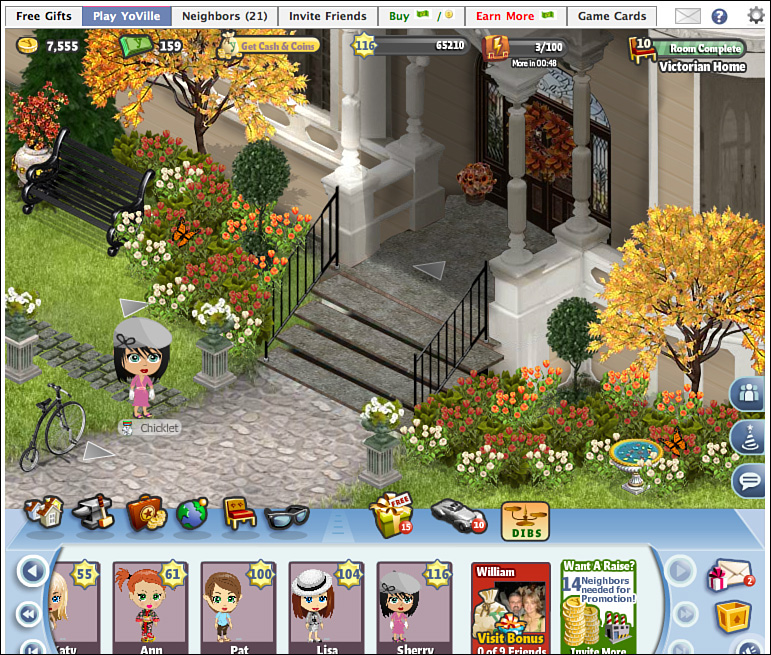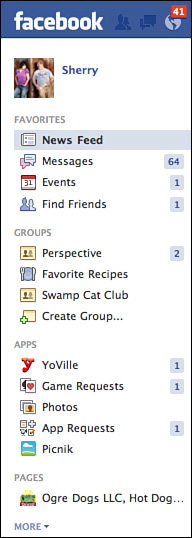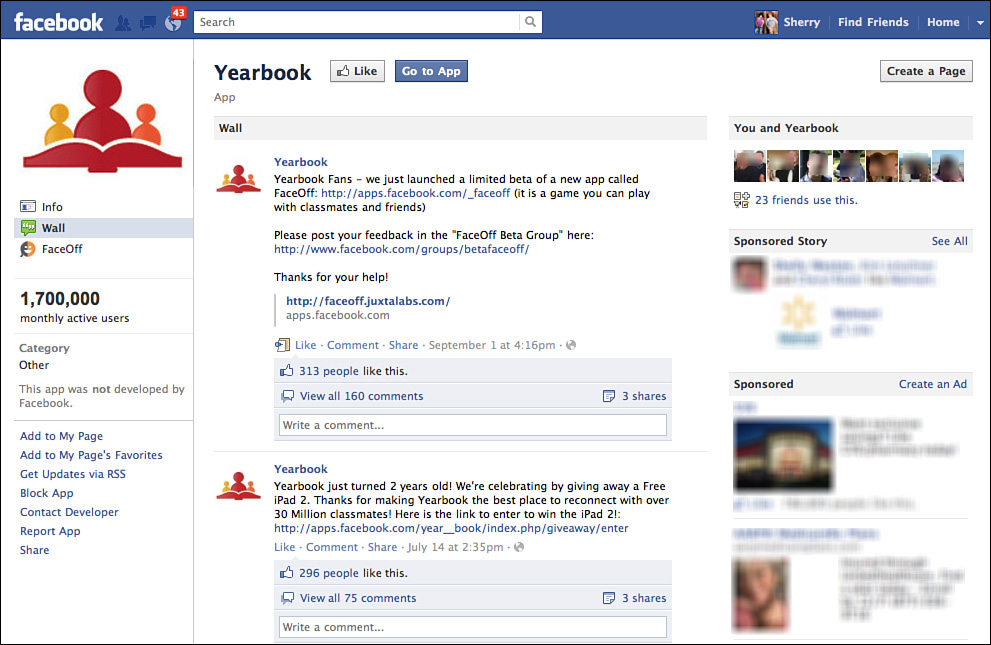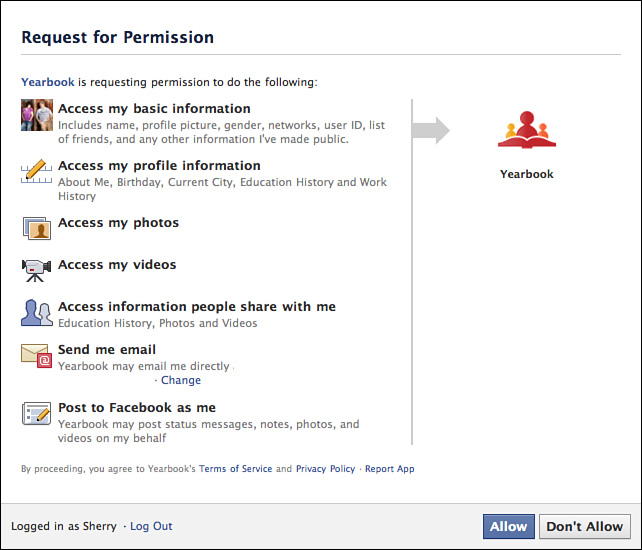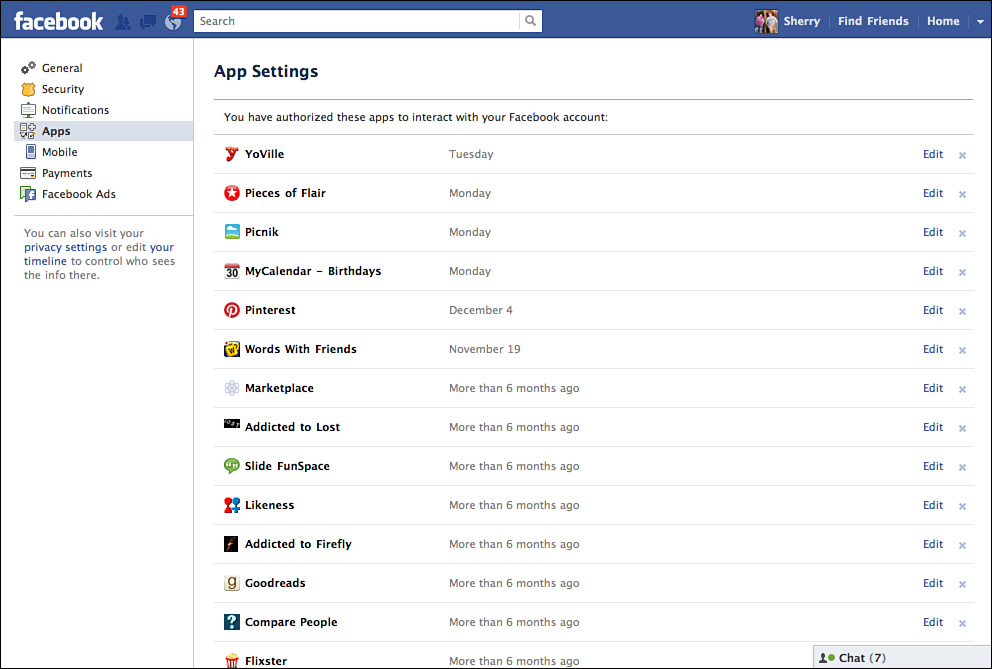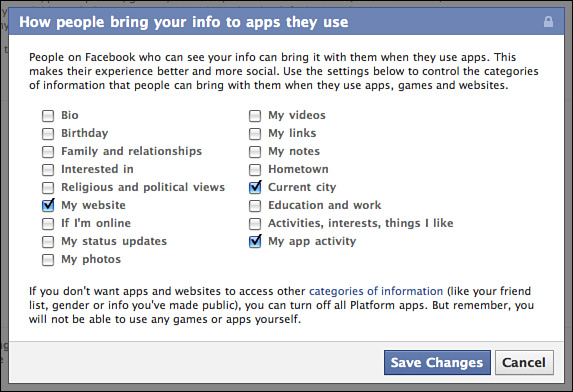Lesson 13. Adding Applications
In this lesson, you learn how to use applications to enhance your Facebook experience. You’ll learn how to search for applications and add interesting ones to your collection. You’ll also learn how to manage your applications, edit their settings, and remove apps you no longer want.
What Are Apps?
Applications are tiny programs that run within the Facebook environment—also called apps for short. Applications are similar to plug-ins you use to enhance your web browser, but in the case of Facebook, they enhance your social networking experiences. You’ve already been using applications on Facebook, perhaps without even knowing it, and we’ve covered quite a few so far in this book. This section will go into them with a bit more detail.
As you know, Facebook has several default applications going as soon as you create your account. If you’ve posted your status, uploaded a photo or video, created a group or event, emailed a message, or chatted online, you’ve used a Facebook app. Apps work seamlessly within the Facebook interface.
Facebook’s designers have included many useful built-in apps, but literally hundreds of applications exist that you can add to your Facebook experience. Some are quite useful, and some are just for fun. These additional applications are created by third-party developers. Facebook has allowed third-party developers free access to the Facebook platform for several years now, so anyone who has some programming experience or wherewithal can write an application for the site. Because of this freedom, Facebook is literally swarming with apps, and many of them are quite clever and creative. You can use as many as you want, and discard those you do not care for after giving them a whirl. All the extra apps you add, however, require your authorization to access your Facebook profile data. In many respects, adding an application is similar to adding a friend to your Friends list. Apps are part of your Facebook account until you discard them. In many cases, apps publish your application activities on your profile page and out in the main news feed. This lets your friends know what applications you use and might inspire them to use them, too—all part of the viral spread of apps on Facebook.
Caution
When you allow an application access to your profile, it accesses all of your information and that of your friends, too. If you’re worried about privacy, applications might not be your cup of tea. For this very reason, you might not want to include too much personal information on your Facebook pages. (To learn more about privacy settings, see Lesson 7, “Guarding Your Privacy.”) You can, however, control some of the invasiveness of apps through the application’s settings. Learn more about editing apps later in this lesson.
Tip
If you want to learn how to create your own apps for Facebook, check out the Developers page for more information, tips, and help. Click the Developers link at the bottom of any Facebook page to investigate further.
Kinds of Apps
At this point, you might be wondering what kinds of things apps offer. A wide variety of applications are available, ranging from business and education to fun and games. For example, culture-sharing apps let you share information about things that interest you and your friends, such as musical tastes, books you just read, or movie reviews. Friendship apps include applications designed to organize and interact with friends. Game apps let you play interactive or single-player games.
One of the more popular apps is FamilyLink’s We’re Related, an application to help you locate and connect with relatives around the globe.
Another popular application just for fun is Flixter, which helps you and your friends compare movie tastes. Some apps create digital worlds where you can interact with other people, such as FarmVille (the most popular app on Facebook), YoVille (see Figure 13.1), or Mafia Wars (all created by Zynga games), whereas other apps enhance a popular Facebook activity, such as Birthday Cards (sending electronic birthday cards to friends) or MyCalendar (for helping you keep track of birthdays).
Figure 13.1 In YoVille, you can wander around a digital world collecting coins and shopping for stuff for your digital dwelling, as well as interacting with your Facebook friends who also exist in YoVille.
Note
Facebook applications are free to use; however, some apps ask for donations for a cause or offer additional privileges for a small fee, such as games. You can decide whether to pursue these extra costs.
Finding Apps
You can encounter applications in several ways on Facebook. Friends might send you an app request, such as a game application in which they invite you to play or interact with them, or a “gift” you must then use the application to view. Application requests typically occur when a friend adds a new application to their repertoire, and it asks to add you, as well, because you’re on their Friends list. Application requests show up in the App Requests link on your Home page (left side of the page under the Apps heading). As you learned back in Lesson 5, “Navigating the Home Page,” all of your Facebook notifications show up in the left pane of the Home page.
Speaking of the Home page, you might notice your Facebook friends playing games or using apps by the listings that appear over on the ticker, the real-time scrollable list that appears in the upper-right corner of the Home page. This is another area to observe with regard to checking out what apps your friends are using. This same ticker also appears when you’re playing apps, and lists similar stories from your friends.
You can also encounter apps on other people’s profile pages. If you see something you think you would enjoy, you can click the application name in the story posting to learn more about the application.
Finally, you can use Facebook’s Apps Dashboard to browse for apps or use Facebook’s Search tool to look for specific ones to learn more about them. The Apps Dashboard, itself an application, lets you browse for apps based on recommended Facebook apps, new apps, or apps your friends are using.
Deciding which apps are right for you is really a personal preference. Many of the Facebook apps are viral, quickly spreading in popularity as they’re shared among friends—your friend adds the application, it looks interesting, so you add it, too. If you see an app you want to try, you can check out its page first to learn more about it and find out which of your friends is using the app.
Responding to an App Request
Basically, an application request is when an app invites you to participate in whatever it’s about, or when your friend who uses the app wants to invite you to use it, too. When you receive an application request, it appears in the left pane area of your Home page listed next to the App Requests link, as shown in Figure 13.2. If you receive a game request, it appears next to the Game Requests link. Click App Requests to view the Apps page, as shown in Figure 13.3.
Figure 13.2 Look for app requests under the Apps heading on your Home page.
Figure 13.3 The Apps page lists any of the app requests you’ve received from friends, along with recommendations from Facebook.
The top of the Apps page displays your requests. (Learn about the bottom of the Apps page in the next section.) You can respond to a request in several ways:
• The first option, though it might have different names, is essentially a button you can click to join, accept, or participate. In Figure 13.3, for example, I can click the Accept button to add the app to my Facebook collection. When clicked, additional pages may open where you can allow the application to access your data.
• The second option is to remove the request by clicking the Delete button (X).
• A third option may be just to ignore the request. Look for an Ignore or Ignore All link and click it.
If you prefer to learn more about the application before choosing a request response, you can visit the app’s info or “profile” page and learn more about it. Move your mouse pointer over the app name that appears in the request area to view a pop-up box; click the app name in the box to go directly to the app’s profile page. Similar to a regular profile page, an application’s profile, shown in Figure 13.4, offers basic information, a Wall for comments, and even a profile picture. Also on the app’s profile page, you’ll find another button for adding the app if you decide you need to install it; click Go to App to start the procedure.
Figure 13.4 Learn more about an app by viewing its profile page.
When you do decide to add an app, a Request for Permission page appears, similar to the one shown in Figure 13.5. If you agree with the permissions requested, click the Allow button and add the app. If you don’t agree, click the Don’t Allow button instead.
Figure 13.5 Before you add an app, you’ll need to give it permission to access your Facebook data.
Apps you add appear listed on your Home page under the Apps heading, with the most-used apps in view, or you can see a full list by actually clicking the Apps heading label.
Browsing Apps with the Apps Dashboard
Time to talk about the bottom portion of the Apps page, shown in Figure 13.6; with literally hundreds of apps to choose from, finding apps is easier when you can just view a few from a top picks list. To see a sampling of top picks, scroll to the bottom portion of the Apps Dashboard (also known as the Apps page) and browse among the recommendations, new apps, or a list of apps your friends are using. As mentioned in the previous section, you can display the page simply by clicking the Apps Request link. If the link isn’t visible, click the More link next to the Apps heading, and then click the App Request link on the page that appears.
Figure 13.6 The bottom portion of the Apps page lists recommended apps, new apps, and apps your friends are using.
Click the Recommended Apps tab to view a list of Facebook-recommended apps. To see a sampling of new apps, click the Newest tab. To see what apps your friends are using, click the Friends Using tab. From any of the apps that appear, you can click an app name to add it. If you want to check it out first, click the app’s link name on the Request for Permission page.
Using Keywords to Search for Apps
You can also conduct a keyword search to look for a specific application. Simply type in the keyword or words you want to search for in the Search box at the top of any Facebook page and click the See More Results link at the bottom of the pop-up menu that appears.
On the results page, click the Apps filter to view just the apps that match your search criteria.
Managing Apps
After you’ve added an application, you can use it as much or as little as you want. Depending on the app, you can change how it’s accessed. You can control apps through the Apps Settings page. (See the next section to learn more.) Some apps even let you put a bookmark icon on the Home page for quicker access.
Changing Application Settings
You can edit your applications through the Apps Settings page, shown in Figure 13.7. To navigate to the page, click the drop-down arrow next to the Home button on any Facebook page and click Account Settings. This opens the Account Settings page. Click the Apps link on the left side of the page to display the Apps Settings.
Figure 13.7 Use the Apps Setting page to control your Facebook apps.
The Apps Settings page lists each of the applications you are using.
To edit an application from your list, click the Edit link. This displays an area detailing the app’s activities and settings. For example, in Figure 13.8, the YoVille app settings tell me what data I have allowed it to access. Depending on the application, you might be able to change privacy settings, add a bookmark, or control how related stories are generated when using the application. To control who sees your app activities, click the Audience Selector drop-down list and choose an audience, such as a custom friends list. Click Close to close out the app’s details.
Figure 13.8 You can view each app’s details and change the settings, as needed.
To view more information about the application, click the app’s name link. This takes you to the app’s profile page, where you can view its description, see which friends are using it, post comments on the Wall, and more.
Note
You can also find your way to the Apps Settings page through Facebook’s Privacy features. When you open the privacy settings to the Apps options, you can click the Edit Settings button to visit the Apps Settings page.
Controlling App Privacy
One of the biggest behind-the-scenes aspects of any app is its sharing of your info. This is particularly true when your friends add new apps and allow them access to your info. As you can see from the Request for Permission pages you jump through to add an app (refer to Figure 13.5), shared information includes your basic profile info and email address, and can even include access to your photos and videos. Shared info also includes info about people on your friends list. Re-sharing is a default setting for just about everything on Facebook. The main reason behind all the openness of info sharing is it helps make the whole social network adventure more personalized, and more, well, social. Thankfully, through the Facebook Privacy settings, you can control what bits of information from your profile are utilized by the apps other people use.
To find your way to the privacy settings, click the drop-down arrow next to the Home button on any Facebook page and click Privacy Settings. This opens the Privacy Settings page. Click the Edit Settings button next to the Apps and Websites heading. This opens a page for controlling how apps, games, and websites use your data. Click the Edit Settings button next to the heading How People Bring Your Info to Apps They Use. This opens a dialog box by the same name, as shown in Figure 13.9. Here you can select which bits of information from your profile are shared with apps your friends use. After you’ve made your selections, click the Save Changes button.
Figure 13.9 You can specify exactly which bits of information are shared with apps by using this dialog box.
If you want to block all apps from any of your info, you must turn off all the platform’s apps and websites.
Removing Apps
You can remove an application you no longer want or are no longer using. You might also remove applications to clean up your list just as a maintenance task. To delete an app, first open the Apps Settings page as described in the previous section. Next, click the Delete link (the X button to the far right of the application name). A prompt box appears. Click the Remove button to delete the application. Optionally, and depending on the application, you can rate the application or state a reason as to why you’re removing it.
One more prompt box appears to let you know the application is gone. Click Okay to finish the process.
Summary
In this lesson, you learned how to use applications on Facebook. You learned how to find applications and add applications to your Facebook account. You also learned how to manage your apps. In the next lesson, you’ll learn how to create Facebook Pages (with a capital P).

